Benefits and Drawbacks of Coopetition: The Roles of Scope and Durability in Coopetitive Relationships
Abstract
1. Introduction
- (1)
- What role does time play in the creation of benefits and disadvantages in specific areas related to coopetition?
- (2)
- Are there any individual benefits (or groups of benefits) leading to sustainability, and what are the corresponding costs?
- (3)
- In which areas is the cost–benefit relationship most beneficial and why?
2. Theoretical Background of Coopetition
2.1. Benefits of Coopetition
2.2. Drawbacks of Coopetition
2.3. Duration of Coopetition
3. Materials and Methods
4. Results and Discussion
- X1—
- duration of coopetition: t < 1, 1 ≤ t < 3, 3 ≤ t < 5, 5 ≤ t < 7, t ≥ 7;
- X2—
- repeatability of coopetition: very frequent, frequent, medium frequency, rare, one-time;
- X3—
- the impact of coopetition on company development: strongly facilitating, facilitating, impeding, strongly impeding, without affecting the development of the company;
- X4—
- benefits of coopetition: very beneficial, beneficial, moderately beneficial, unfavorable.
- X1i—duration of coopetition in the i-th (i = 1, 2, …, 9) area: t < 1, 1 ≤ t < 3, 3 ≤ t < 5, 5 ≤ t < 7, t ≥ 7;
- Y1i—result of coopetition in the i-th (i = 1, 2, …, 9) area: very large benefit, very little benefit, zero effect, very little loss, very big loss.
5. Conclusions
Author Contributions
Funding
Conflicts of Interest
References
- Cygler, J.; Sroka, W. The Boundaries of Coopetition: A Case Study of Polish Companies Operating in the High-Tech Sector. In Economic Development and Entrepreneurship in Transition Economies; Ateljević, J., Trivić, J., Eds.; Springer: Cham, Switzerland, 2016; pp. 253–269. [Google Scholar]
- Oleniuch, I. The food networks as one of the coopetition forms. Forum Sci. Oecon. 2015, 3, 69–77. [Google Scholar]
- Bengtsson, M.; Kock, S. Coopetition in business networks: To cooperate and compete simultaneously. Ind. Mark. Manag. 2000, 29, 411–426. [Google Scholar] [CrossRef]
- Dagnino, G.B. Coopetition strategy. A new kind of interfirm dynamics for value creation. In Coopetition Strategy, Theory, Experiments and Cases; Dagnino, G.G., Rocco, E., Eds.; Routledge Studies in Global Competition: London, UK, 2009. [Google Scholar]
- Lado, A.A.; Boyd, N.G.; Hanlon, S.C. Competition, cooperation, and the search for economic rents: A syncretic model. Acad. Manag. Rev. 1997, 22, 110–141. [Google Scholar] [CrossRef]
- Lane, C.; Backhmann, R. (Eds.) Trust Within and between Organizations; Oxford University Press: Oxford, UK, 1998. [Google Scholar]
- Brito, C.; Costa de Silva, S. When trust becomes the fourth “C” of cooperation. Mark. Rev. 2009, 9, 289–299. [Google Scholar] [CrossRef]
- Harris, S.; Dibben, M. Trust and co-operation in business relationship development: Exploring the influence of national values. J. Mark. Manag. 1999, 15, 463–483. [Google Scholar] [CrossRef]
- Brandenburger, A.M.; Nalebuff, B.J. Co-Opetition. 1. A Revolutionary Mindset That Combines Competition and Cooperation. 2. The Game Theory Strategy That’s Changing the Game of Business; Doubleday: New York, NY, USA, 1996. [Google Scholar]
- Fernandez, A.-S.; Le Roy, F.; Gnyawali, D.R. Sources and management of tension in co-opetition—Case evidence from telecommunications satellites manufacturing in Europe. Ind. Mark. Manag. 2014, 43, 222–235. [Google Scholar] [CrossRef]
- Park, B.; Srivastava, M.K.; Gnyawali, D.R. Walking in the tight rope of coopetition: Impact of competition and cooperation intensities and balance on firm innovation performance. Ind. Mark. Manag. 2014, 43, 210–221. [Google Scholar] [CrossRef]
- Oláh, J.; Karmazin, G.; Fekete Farkas, M.; Popp, J. An examination of trust as a strategical factor of success in logistical firms. Bus. Theor. Pract. 2017, 18, 171–177. [Google Scholar] [CrossRef]
- Bonel, E.; Rocco, E. Coopeting to survive; surviving coopetition. Int. Stud. Manag. Organ. 2007, 37, 70–96. [Google Scholar] [CrossRef]
- Christ, K.L.; Burritt, R.L.; Varsei, M. Coopetition as a potential strategy for corporate sustainability. Bus. Strateg. Environ. 2017, 26, 1029–1040. [Google Scholar] [CrossRef]
- Dyllick, T.; Hockerts, K. Beyond the business case for corporate sustainability. Bus. Strateg. Environ. 2002, 11, 130–141. [Google Scholar] [CrossRef]
- Limoubpratum, C.; Shee, H.; Ahsan, K. Sustainable distribution through coopetition strategy. Int. J. Logist. Res. Appl. 2015, 18, 424–441. [Google Scholar] [CrossRef]
- Solesvik, M.Z.; Gulbrandsen, M. Partner selection for open innovation. Technol. Innov. Manag. Rev. 2013, 3, 11–16. [Google Scholar] [CrossRef]
- Thomason, S.J.; Simendinger, E.; Kiernan, D. Several determinants of successful coopetition in small business. J. Small Bus. Entrep. 2013, 26, 15–28. [Google Scholar] [CrossRef]
- Luo, Y. Toward coopetition within a multinational enterprise: A perspective from foreign subsidiaries. J. World Bus. 2005, 40, 71–90. [Google Scholar] [CrossRef]
- Luo, X.; Slotegraaf, R.; Pan, X. Cross-functional “coopetition”: The simultaneous role of cooperation and competition within firms. J. Mark. 2006, 70, 67–80. [Google Scholar] [CrossRef]
- Tsai, W. Social structure of “coopetition” within a multiunit organization: Coordination, competition, and intraorganizational knowledge sharing. Organ. Sci. 2002, 13, 179–190. [Google Scholar] [CrossRef]
- Cygler, J. Co-opetition in network relations between businesses. Org. Manag. 2010, 1, 59–71. [Google Scholar] [CrossRef]
- Gnyawali, D.R.; Madhavan, R. Cooperative networks and competitive dynamics: A structural embeddedness respective. Acad. Manag. Rev. 2001, 26, 431–445. [Google Scholar] [CrossRef]
- Sanou, F.H.; Le Roy, F.; Gnyawali, D.R. How does centrality in coopetition networks matter? An empirical investigation in the mobile telephone industry. Brit. J. Manag. 2016, 27, 143–160. [Google Scholar] [CrossRef]
- Colley, A.; Roberts, N.; Chipps, A. Sex-role identity, personality and participation in team and individual sports by males and females. Int. J. Sports Psychol. 1985, 16, 103–112. [Google Scholar]
- Lu, L.; Argyle, M. Happiness and cooperation. Pers. Indiv. Differ. 1991, 12, 1019–1030. [Google Scholar] [CrossRef]
- Simmons, C.H.; Simrel King, C.; Settle Tucker, S.; Wehner, E.A. Success strategies: Winning through cooperation or competition. J. Soc. Psychol. 2001, 126, 437–444. [Google Scholar] [CrossRef]
- Ross, S.R.; Rausch, M.K.; Canada, K.E. Competition and cooperation in the five-factor model: Individual differences in achievement orientation. J. Psychol. 2003, 137, 131–139. [Google Scholar] [CrossRef] [PubMed]
- Geraudel, M.; Salvetat, D. What are the antecedents of coopetition? Eur. Bus. Rev. 2014, 26, 23–42. [Google Scholar] [CrossRef]
- Gnyawali, D.; He, J.; Madhavan, R. Co-Opetition: Promises and Challenges in the 21st Century Management: A Reference Handbook; Wankel, C., Ed.; Sage Publications: Thousand Oaks, CA, USA, 2008; Volume 1, pp. 386–398. [Google Scholar]
- Oláh, J.; Bai, A.; Karmazin, G.; Balogh, P.; Popp, J. The role played by trust and its effect on the competiveness of logistics service providers in Hungary. Sustainability 2017, 9, 2303. [Google Scholar] [CrossRef]
- Mayberry, J.P.; Harsanyi, J.C.; Scarf, M.E.; Selten, R. Game-Theoretic Models of Co-Operation and Conflict; Westview Press: San Francisco, CA, USA, 1992. [Google Scholar]
- Axelrod, R. The Evolution of Co-Operation; Basic Books: New York, NY, USA, 1994. [Google Scholar]
- Parkhe, A. Strategic alliances structuring: A game theoretic and transaction cost examination of interfirm co-operation. Acad. Manag. J. 1993, 36, 794–829. [Google Scholar]
- Brandenburger, A.M.; Nalebuff, B.J. The right game: Use game theory to shape strategy. Harv. Bus. Rev. 1995, 73, 57–71. [Google Scholar]
- Williamson, O.E. The Economic Institutions of Capitalism; The Free Press: New York, NY, USA, 1987. [Google Scholar]
- Hennart, J.F. A transaction cost theory of equity joint ventures. Strateg. Manag. J. 1988, 9, 361–374. [Google Scholar] [CrossRef]
- Madhok, A. Transaction (in)efficiency, value (in)efficiency and inter-firm collaboration. In Cooperative Strategy: Economic Business, and Organizational Issues; Faulkner, D., de Rond, M., Eds.; Oxford University Press: Oxford, UK, 2000. [Google Scholar]
- Quintana-García, C.; Benavides-Velasco, C.A. Cooperation, competition, and innovative capability: A panel data of European dedicated biotechnology firms. Technovation 2004, 4, 927–938. [Google Scholar] [CrossRef]
- Park, S.; Russo, M.V. When competition eclipses cooperation: An event history analysis of joint venture failure. Manag. Sci. 1996, 42, 875–890. [Google Scholar] [CrossRef]
- Chen, M.J.; Su, K.H.; Tsai, W. Competitive tension: The awareness-motivation-capability perspective. Acad. Manag. J. 2007, 50, 101–118. [Google Scholar] [CrossRef]
- Hill, C.W.L. Cooperation, opportunism, and invisible hand: Implications for transaction cost theory. Acad. Manag. Rev. 1990, 15, 500–513. [Google Scholar] [CrossRef]
- Selten, R. Features of experimentally observed bounded rationality. Eur. Econ. Rev. 1998, 42, 413–436. [Google Scholar] [CrossRef]
- Chetty, S.K.; Wilson, H.I.M. Collaborating with competitors to acquire resources. Int. Bus. Rev. 2003, 12, 61–81. [Google Scholar] [CrossRef]
- Clarke-Hill, C.; Li, H.; Davis, B. The paradox of co-operation and competition in strategic alliances: Towards a multi-paradigm approach. Manag. Res. News 2003, 26, 1–20. [Google Scholar] [CrossRef]
- Das, T.K.; Teng, B.S. Instabilities of strategic alliances: An internal tensions perspective. Org. Sci. 2000, 11, 77–101. [Google Scholar] [CrossRef]
- Heimeriks, K.H.; Duysters, G. Alliance capability as a mediator between experience and alliance performance: An empirical investigation into the alliance capability development process. J. Manag. Stud. 2007, 44, 25–49. [Google Scholar] [CrossRef]
- Vaidya, S. Understanding strategic alliances: An integrated framework. J. Manag. Policy Prac. 2011, 12, 90–100. [Google Scholar]
- Lechner, C.; Soppe, B.; Dowling, M. Vertical coopetition and sales growth of young and small firms. J. Small Bus. Manag. 2016, 54, 67–84. [Google Scholar] [CrossRef]
- Gnyawali, D.; He, J.; Madhavan, R. Impact of co-opetition on firm competitive behaviour: An empirical examination. J. Manag. 2006, 32, 179–197. [Google Scholar]
- Lechner, C.; Dowling, M.; Welpe, I. Firm networks and firm development: The role of the relational mix. J. Bus. Ventur. 2006, 21, 514–540. [Google Scholar] [CrossRef]
- Peng, T.-J.; Bourne, M. The coexistence of competition and cooperation between networks: Implications from two Taiwanese healthcare networks. Br. J. Manag. 2009, 20, 377–400. [Google Scholar] [CrossRef]
- Doz, Y.; Hamel, G. Alliance Advantage. The Art of Creating Value through Partnering; Harvard Business School Press: Boston, MA, USA, 1998. [Google Scholar]
- Luo, Y. Coopetition in International Business; Copenhagen Business School Press: Copenhagen, Denmark, 2004. [Google Scholar]
- Cygler, J. Structural pathology in inter-organizational networks and the decision-making autonomy of its members. In Management of Network Organizations. Theoretical Problems and Dilemmas in Practice; Sroka, W., Hittmár, Š., Eds.; Springer: New York, NY, USA, 2015. [Google Scholar]
- Geradin, D.; McCahery, J.A. Regulatory Co-Opetition: Transcending the Regulatory Competition Debate; TILEC Discussion Paper; Tilburg University: Tilburg, The Netherlands, 2005. [Google Scholar]
- Levin, M.A.; McDonald, R.E. R-A theory as a post-Chicago argument for legal coopetition. Mark. Manag. J. 2006, 16, 1–12. [Google Scholar]
- Edmonson, A.C.; McManus, S.E. Methodological fit in management field research. Acad. Manag. Rev. 2007, 32, 1155–1179. [Google Scholar]
- Soppe, B.; Lechner, C.; Dowling, M. Vertical coopetition in entrepreneurial firms: Theory and practice. J. Small Bus. Enterp. Dev. 2014, 21, 548–564. [Google Scholar] [CrossRef]
- Cygler, J.; Sroka, W. Coopetition disadvantages: The case of the high tech companies. Eng. Econ. 2017, 28, 494–504. [Google Scholar] [CrossRef]
- D’Aveni, R.A.; Gunther, R. Hypercompetitive Rivals. Competing in Highly Dynamic Environments; The Free Press: New York, NY, USA, 1995. [Google Scholar]
- Van de Gevel, A.J.W. From Confrontation to Coopetition in the Globalized Semiconductor Industry; Tilburg University: Tilburg, The Netherlands, 2000. [Google Scholar]
- World Investment Report. Non-Equity Modes of International Production and Development; UNCTAD: New York, NY, USA, 2011. [Google Scholar]
- OECD. New Patterns of Industrial Globalisation: Cross-Border Mergers and Acquisitions and Strategic Alliances; OECD: Paris, France, 2001. [Google Scholar]
- Gnyawali, D.R.; Park, B.J. Co-opetition between giants: Collaboration with competitors for technological innovation. Res. Policy 2011, 40, 650–663. [Google Scholar] [CrossRef]
- Ganguli, S. Coopetition models in the context of modern business. ICFAI J. Mark. Manag. 2007, 6, 6–16. [Google Scholar]
- Nemeh, A.; Yami, S. The Determinants of the emergence of coopetition strategy in R&D. Int. Stud. Manag. Org. 2016, 46, 159–178. [Google Scholar]
- Zineldin, M.; Dodurova, M. Motivation, achievements and failure of strategic alliances. The case of Swedish auto-manufacturers in Russia. Eur. Bus. Rev. 2005, 17, 460–470. [Google Scholar] [CrossRef]
- Nygaard, A.; Dahlstrom, R. Role of stress and effectiveness in horizontal alliances. J. Mark. 2002, 66, 61–82. [Google Scholar] [CrossRef]
- Cruijssen, F.; Cools, M.; Dullaert, W. Horizontal cooperation in logistics: Opportunities and impediments. Transp. Res. Part. E Logist. Transp. Rev. 2007, 43, 129–142. [Google Scholar] [CrossRef]
- Das, T.K.; Rahman, N. Determinants of partner opportunism in strategic alliances: A conceptual framework. J. Bus. Psychol. 2010, 25, 55–74. [Google Scholar] [CrossRef]
- Belderbos, R.; Gilsing, V.; Lokshin, B. Persistence of, and interrelation between horizontal and vertical technology alliances. J. Manag. 2012, 38, 1812–1834. [Google Scholar] [CrossRef]
- Wallenburg, C.M.; Schäffler, T. The interplay of relational governance and formal control in horizontal alliances: A social contract perspective. J. Supply Chain Manag. 2014, 50, 41–58. [Google Scholar] [CrossRef]
- Solesvik, M.Z.; Westhead, P. Partner selection for strategic alliances: Case study insights from the maritime industry. Ind. Manag. Data Syst. 2010, 110, 841–860. [Google Scholar] [CrossRef]
- Sroka, W.; Cygler, J.; Gajdzik, B. The transfer of knowledge in intra-organizational networks: A case study analysis. Organizacija 2014, 47, 24–34. [Google Scholar] [CrossRef]
- Šebestová, J.; Šperka, R.; Małecka, J.; Łuczka, T. Co-working centres as a potential supportive network for cross-border business cooperation. Forum Sci. Oecon. 2017, 5, 23–34. [Google Scholar]
- Silverman, B.S.; Baum, J.A.C. Alliance-based competitive dynamics. Acad. Manag. J. 2002, 45, 791–806. [Google Scholar]
- Carayannis, E.G.C.; Alexander, J. Strategy, structure and performance issues of precompetitive R&D consortia: Insights and lessons learned from SEMATECH. IEEE Trans. Eng. Manag. 2004, 51, 226–232. [Google Scholar]
- Zineldin, M. Co-opetition: The organisation of the future. Mark. Intell. Plan. 2004, 22, 780–789. [Google Scholar] [CrossRef]
- Ritala, P. Coopetition strategy—When is it successful? Empirical evidence on innovation and market performance. Br. J. Manag. 2012, 23, 307–324. [Google Scholar] [CrossRef]
- Padula, G.; Dagnino, G.B. Untangling the rise of coopetition: The intrusion of competition in a cooperative game structure. Int. Stud. Manag. Org. 2007, 37, 32–52. [Google Scholar] [CrossRef]
- Ahuja, G. The duality of collaboration: Introducing and opportunities in the formation of inter-firm linkage. Strateg. Manag. J. 2000, 21, 317–343. [Google Scholar] [CrossRef]
- Gnyawali, D.R.; Park, B.-J.R. Coopetition in technological innovation in small and medium-sized enterprises: A multilevel conceptual model. J. Small Bus. Manag. 2009, 47, 308–330. [Google Scholar] [CrossRef]
- Luo, Y. A coopetition perspective of global competition. J. World Bus. 2007, 42, 129–144. [Google Scholar] [CrossRef]
- Bengtsson, M.; Eriksson, J.; Wincent, J. Coopetition: New ideas for a new paradigm in coopetition. In Coopetition: Winning Strategies for 21st Century; Yami, S., Castaldo, S., Dagnino, G.B., Le Roy, F., Eds.; Edward Elgar Publishing, Inc.: Cheltenham, UK, 2010; pp. 19–39. [Google Scholar]
- Le Roy, F.; Sanou, F.H. Does coopetition strategy improve market performance? An empirical study in mobile phone industry. J. Econ. Manag. 2014, 17, 63–94. [Google Scholar]
- Luo, X.; Rindfleisch, A.; Tse, D.K. Working with rivals: The impact of competitor alliances on financial performance. J. Mark. Res. 2007, XLIV, 73–83. [Google Scholar] [CrossRef]
- Ritala, P.; Hurmelinna-Laukkanen, P. What’s in it for me? Creating and appropriating value in innovation-related coopetition. Technovation 2009, 29, 819–829. [Google Scholar] [CrossRef]
- Coy, P. Sleeping with the enemy. More companies are finding that “co-opetition”, or learning to work with rivals on certain projects, may be the best strategy. Bus Week, 21–28 August 2006; 96–97. [Google Scholar]
- Nevin, M. The Strategic Alliance Handbook. A Practitioners Guide to Business-to-Business Collaborations; Gower Publishing: Burlington, NJ, USA, 2014. [Google Scholar]
- Dowling, M.J.; Roering, W.D.; Carlin, B.A.; Wisniewski, J. Multifaceted relationships under coopetition. Description and theory. J. Manag. Inq. 1996, 5, 155–167. [Google Scholar] [CrossRef]
- Lavie, D. The competitive advantage of interconnected firms: An extension of the resource-based view. Acad. Manag. Rev. 2006, 31, 638–658. [Google Scholar] [CrossRef]
- Hamel, G. Competition for competence and interpartner learning within international strategic alliances. Strateg. Manag. J. 1991, 12, 83–103. [Google Scholar] [CrossRef]
- Nohria, N.; Garcia-Pont, C. Global strategic linkages and industry structure. Strateg. Manag. J. 1991, 12, 105–124. [Google Scholar] [CrossRef]
- Hamel, G.; Prahalad, C.K. Competing for the Future; Harvard Business School Press: Boston, MA, USA, 1994. [Google Scholar]
- Ritala, P.; Hallinkas, J.; Sissonen, H. The effect of strategic alliances between key competitors on firm performance. Manag. Res. J. Iberoam. Acad. Manag. 2008, 6, 179–187. [Google Scholar] [CrossRef]
- Porter, M.E. The Comparative Advantages of Nations; Free Press: New York, NY, USA, 1990. [Google Scholar]
- Inkpen, A.C.; Ross, J. Why do some strategic alliances persist beyond their useful life? Calif. Manag. Rev. 2001, 44, 132–148. [Google Scholar] [CrossRef]
- Morris, M.H.; Koçak, A.; Özer, A. Coopetition as a small business strategy: Implications for performance. J. Small Bus. Strateg. 2007, 18, 35–55. [Google Scholar]
- Bouncken, R.B.; Gast, J.; Kraus, S.; Bogers, M. Coopetition: A systematic review, synthesis, and future research directions. Rev. Manag. Sci. 2015, 9, 577–601. [Google Scholar] [CrossRef]
- Bouncken, R.B.; Fredrich, V.; Ritala, P.; Kraus, S. Coopetition in new product development alliances: Advantages and tensions for incremental and radical innovation. Br. J. Manag. 2017, 00, 1–20. [Google Scholar] [CrossRef]
- Tidström, A. Managing tensions in coopetition. Ind. Mark. Manag. 2014, 43, 261–271. [Google Scholar] [CrossRef]
- Khanna, T.; Gulati, R.; Nohria, N. The dynamics of learning alliances: Competition, cooperation, and relative scope. Strateg. Manag. J. 1998, 19, 193–210. [Google Scholar] [CrossRef]
- Raza-Ullah, T.; Bengtsson, M.; Kock, S. The coopetition paradox and tension in coopetition at multiple levels. Ind. Mark. Manag. 2014, 43, 189–198. [Google Scholar] [CrossRef]
- Das, T.K.; Teng, B.-S. A resource-based theory of strategic alliances. J. Manag. 2000, 26, 31–61. [Google Scholar] [CrossRef]
- Das, T.K. Strategic alliance temporalities and partner opportunism. Br. J. Manag. 2006, 17, 1–21. [Google Scholar] [CrossRef]
- Ingram, P.; Yue, L.Q. Structure, affect and identity as bases of organizational competition and cooperation. Acad. Manag. Ann. 2008, 2, 275–303. [Google Scholar] [CrossRef]
- Chou, H.H.; Zolkiewski, J. Coopetition and value creation and appropriation: The role of interdependencies, tensions and harmony. Ind. Mark. Manag. 2018, 70, 25–33. [Google Scholar] [CrossRef]
- Ceptureanu, S.I.; Ceptureanu, E.G.; Olaru, M.; Vlad, L.B. An exploratory study on coopetitive behaviour in oil and gas distribution. Energies 2018, 11, 1234. [Google Scholar] [CrossRef]
- Osarenkhoe, A. A study of inter-firm dynamics between competition and cooperation—A coopetition strategy. J. Database Mark. Cust. Strateg. Manag. 2010, 17, 201–221. [Google Scholar] [CrossRef]
- Tomski, P. The horizons of coopetition—The analysis of the selected aspects of application. Organ. Vadyba Syst. Tyrima 2011, 59, 131–147. [Google Scholar]
- Gomes-Casseres, B. Alliance strategies of small firms. Small Bus. Econ. 1997, 9, 33–44. [Google Scholar] [CrossRef]
- D’Aveni, R.D. Waking up to the new era of hypercompetition. Wash. Quart 1998, 21, 183–195. [Google Scholar] [CrossRef]
- Reiss, M. Hyper-Coopetition. A Complexity-Based Approach to Production Management in the New Economy; Working Paper; University of Stuttgart: Stuttgart, Germany, 2003. [Google Scholar]
- Farrell, D. Beyond offshoring: Assess your company’s global potential. Harv. Bus. Rev. 2004, 82, 82–90. [Google Scholar] [PubMed]
- Chirgui, Z.M. The economics of the smart card industry: Towards coopetitive strategies. Econ. Innov. New Technol. 2005, 14, 455–477. [Google Scholar] [CrossRef]
- Chien, T.-H.; Peng, T.-J. Competition and cooperation intensity in a network—A case study in Taiwan simulator industry. J. Am. Acad. Bus. 2005, 7, 150–155. [Google Scholar]
- Sharma, M.G. Servitization, coopetition, and sustainability: An operations perspective in aviation industry. Vikalpa. J. Decis. Mak. 2017, 42, 145–152. [Google Scholar]
- Akpinar, M.; Vincze, Z. The dynamics of coopetition: A stakeholder view of the German automotive industry. Ind. Mark. Manag. 2016, 57, 53–63. [Google Scholar] [CrossRef]
- Robert, M.; Chiambaretto, P.; Mira, B.; Le Roy, F. Better, faster, stronger, the impact of market oriented coopetition on product commercial performance. Management 2018, 21, 574–610. [Google Scholar] [CrossRef]
- OECD. OECD Science, Technology and Industry Scoreboard; OECD Publishing: Paris, France, 2003. [Google Scholar]
- Greenacre, M.J. Theory and Applications of Correspondence Analysis; Academic Press: London, UK, 1984. [Google Scholar]
- Levy, R.; Roux, P.; Wolff, S. An analysis of science-industry collaborative patterns in a large European University. J. Technol. Transf. 2009, 34, 1–23. [Google Scholar] [CrossRef]
- Greencare, M.; Hastie, T. The geometric interpretation of correspondence analysis. J. Am. Stat. Assoc. 1987, 82, 437–447. [Google Scholar] [CrossRef]
- Press, W.H.; Teukolsky, S.A.; Vetterling, W.T.; Flannery, B.P. Numerical Recipes: The Art of Scientific Computing, 3rd ed.; Cambridge University Press: Cambridge, UK, 2007. [Google Scholar]
- Raeder, T.; Chawla, N.V. Market basket analysis with networks. Soc. Netw. Anal. Min. 2011, 1, 97–113. [Google Scholar] [CrossRef]
- Tan, P.; Steinach, M.; Kumar, V. Introduction to Data Mining; Pearson Education, Inc.: Boston, MA, USA, 2006. [Google Scholar]
- Bouncken, R.B.; Fredrich, V. Learning in coopetition: Alliance orientation, network size, and firm types. J. Bus. Res. 2016, 69, 1753–1758. [Google Scholar] [CrossRef]
- Solesvik, M.; Gulbrandsen, M. Interaction for innovation: Comparing Norwegian regions. J. Entrep. Manag. Innov. 2014, 10, 7–28. [Google Scholar]
- Borch, O.J.; Solesvik, M.Z. Partner selection versus partner attraction in R&D strategic alliances: The case of the Norwegian shipping industry. Int. J. Tech. Mark. 2016, 11, 421–439. [Google Scholar]
- Solesvik, M.Z. Interfirm collaboration in the shipbuilding industry: The shipbuilding cycle perspective. Int. J. Bus. Syst. Res. 2011, 5, 388–405. [Google Scholar] [CrossRef]
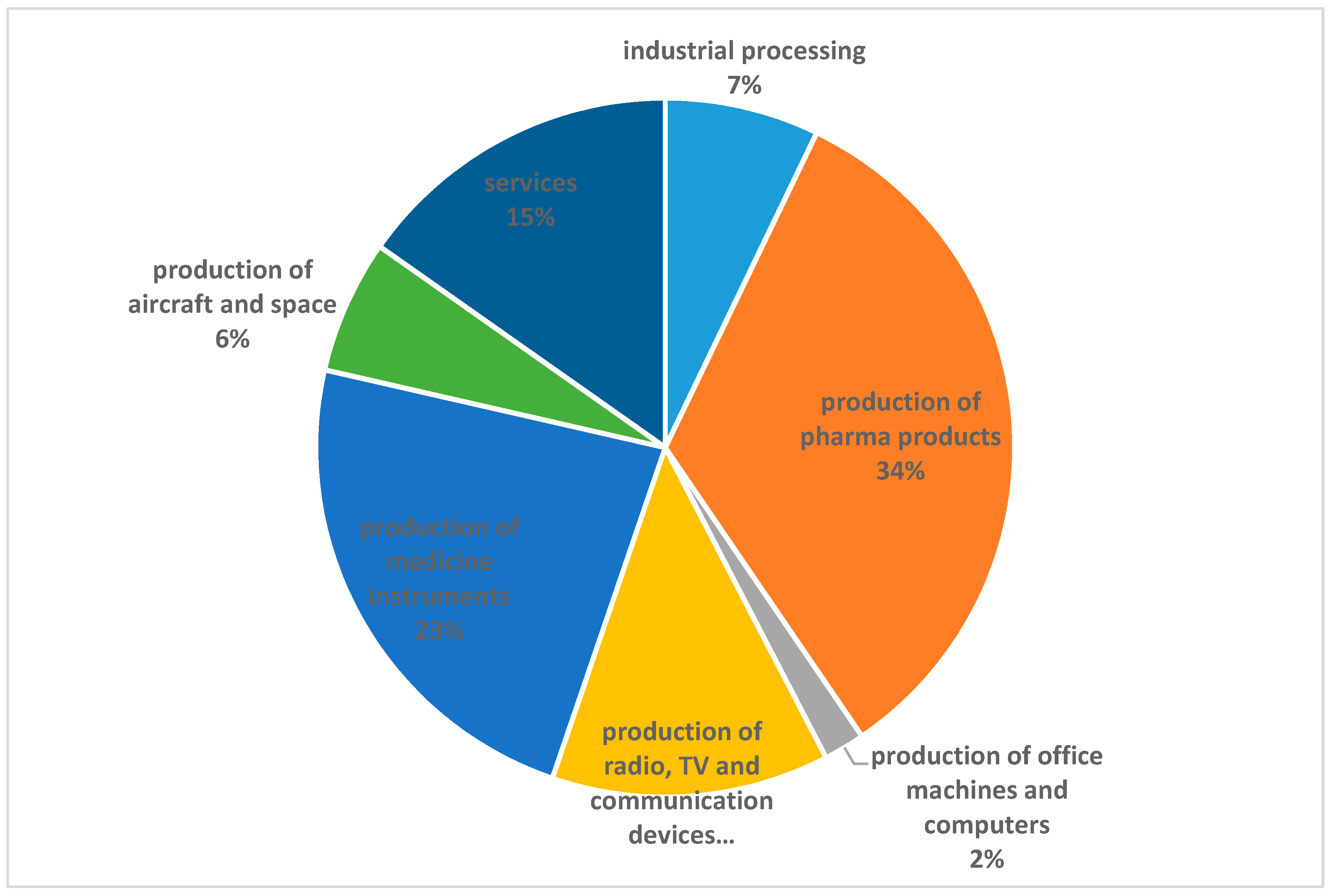
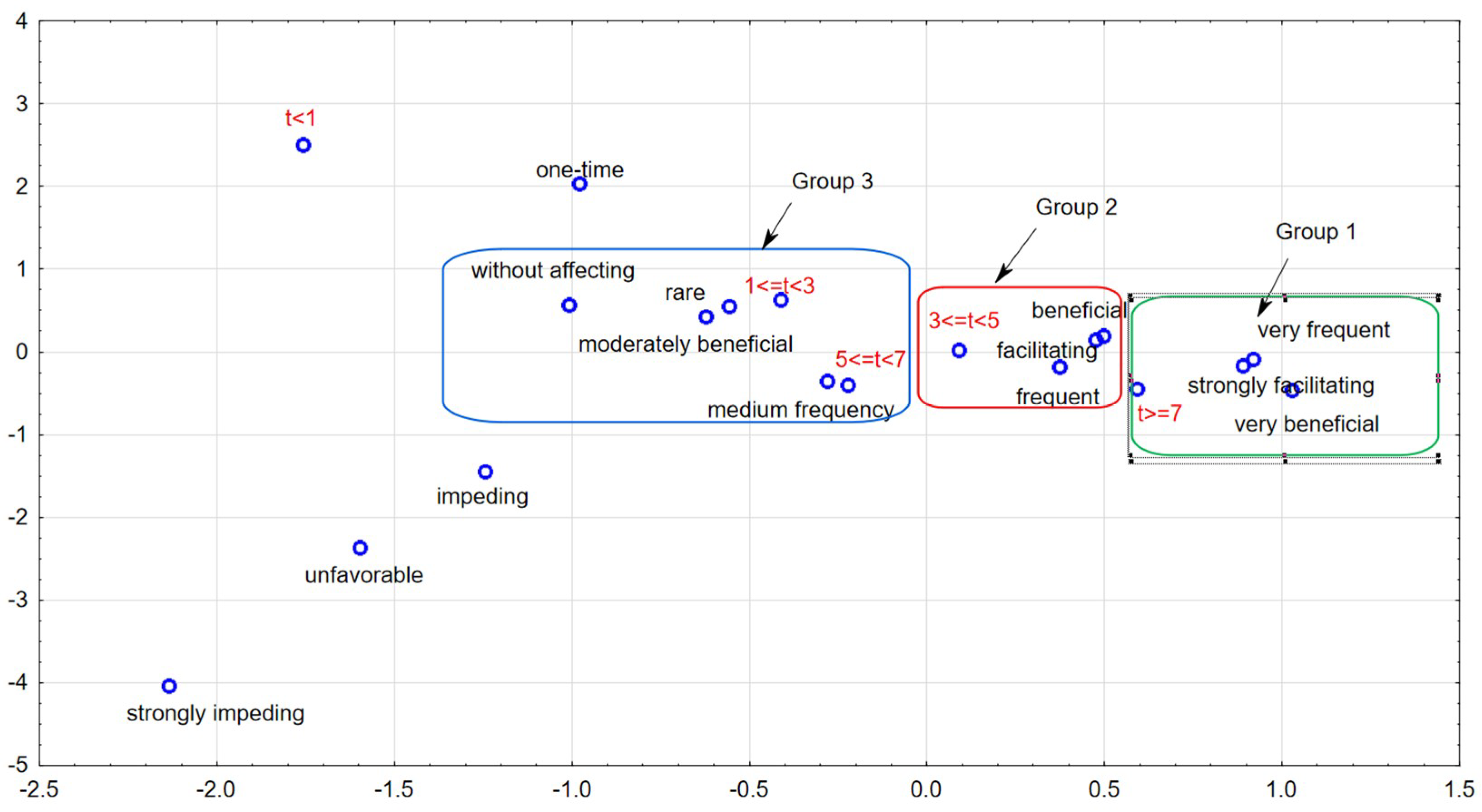
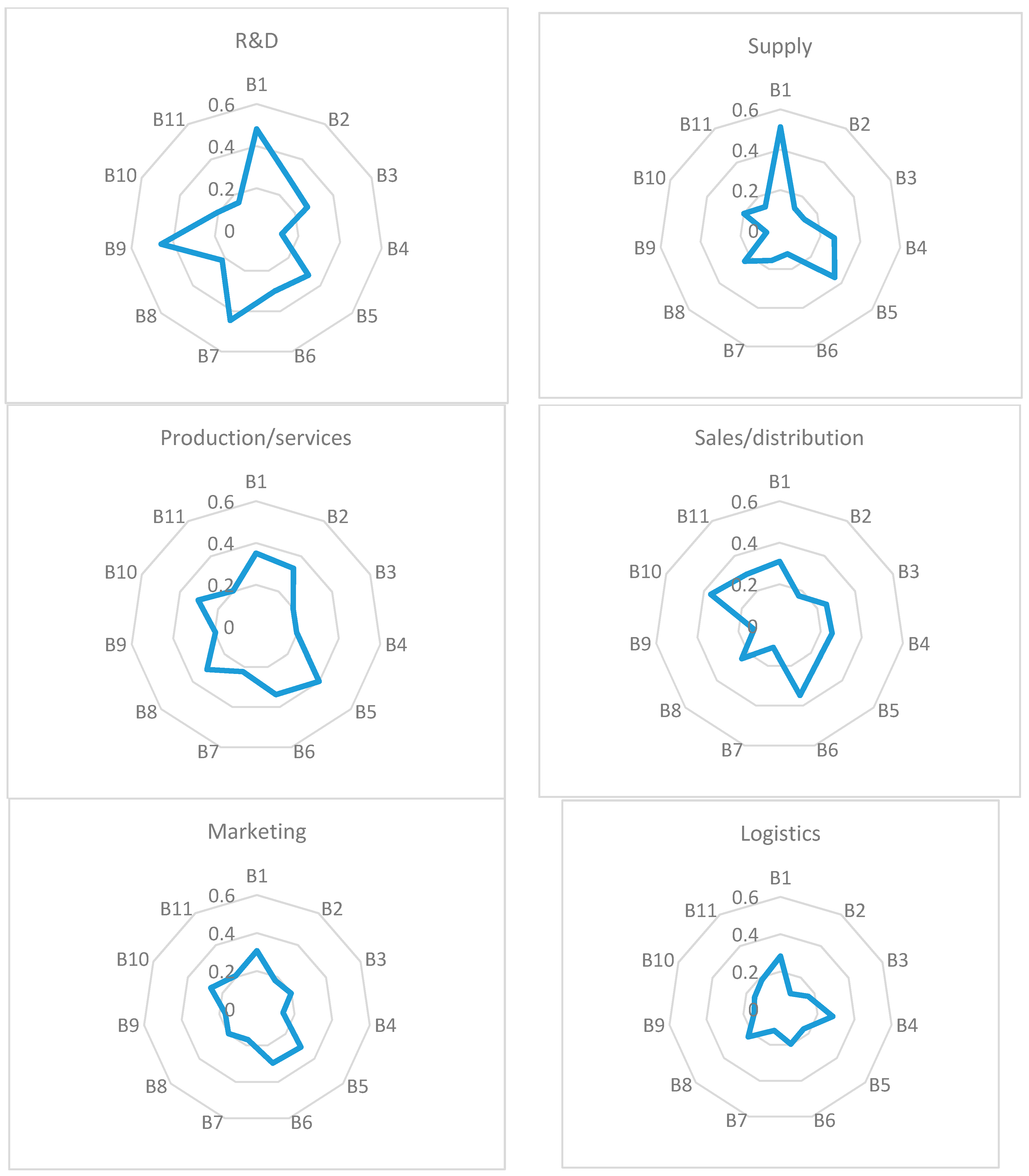
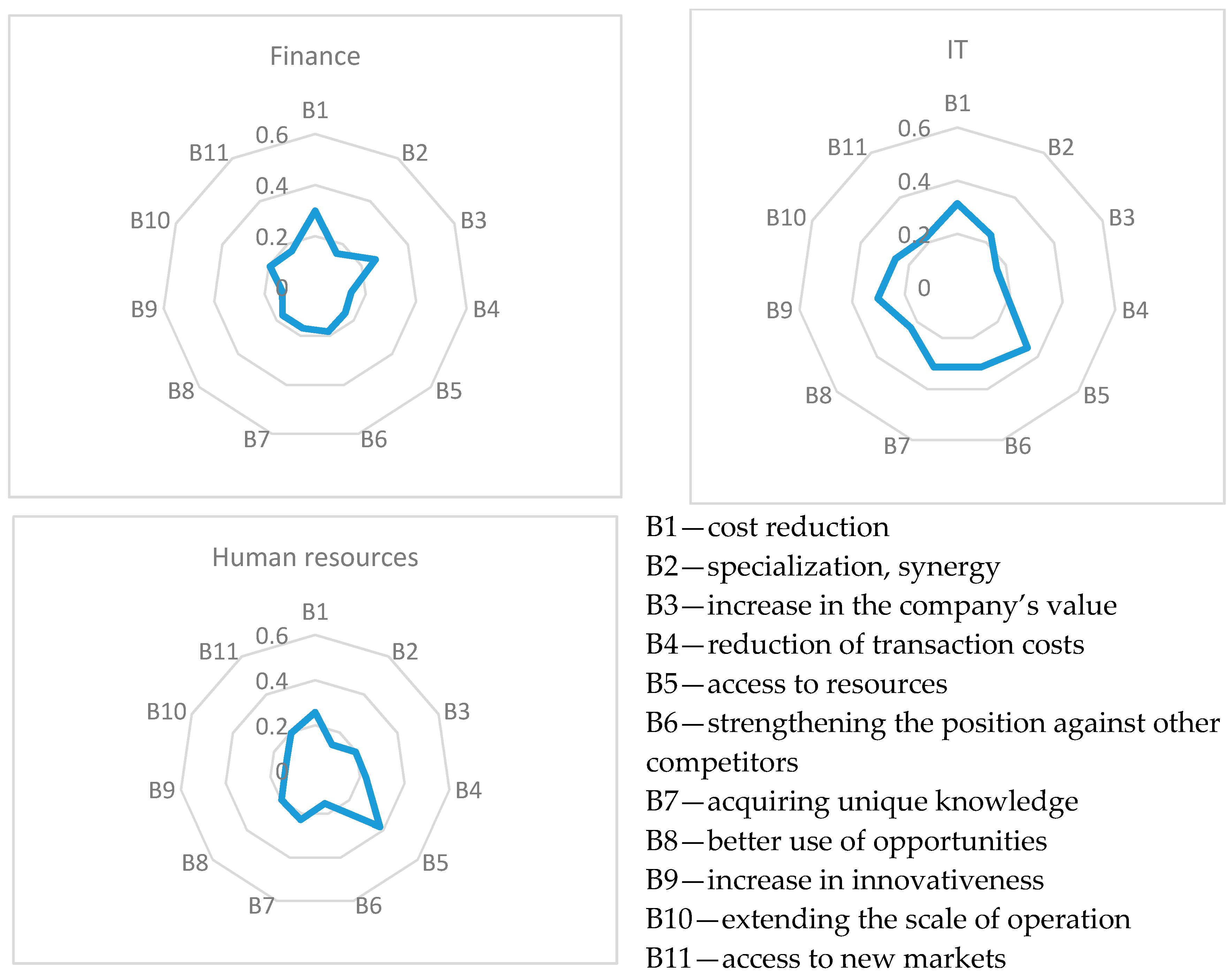

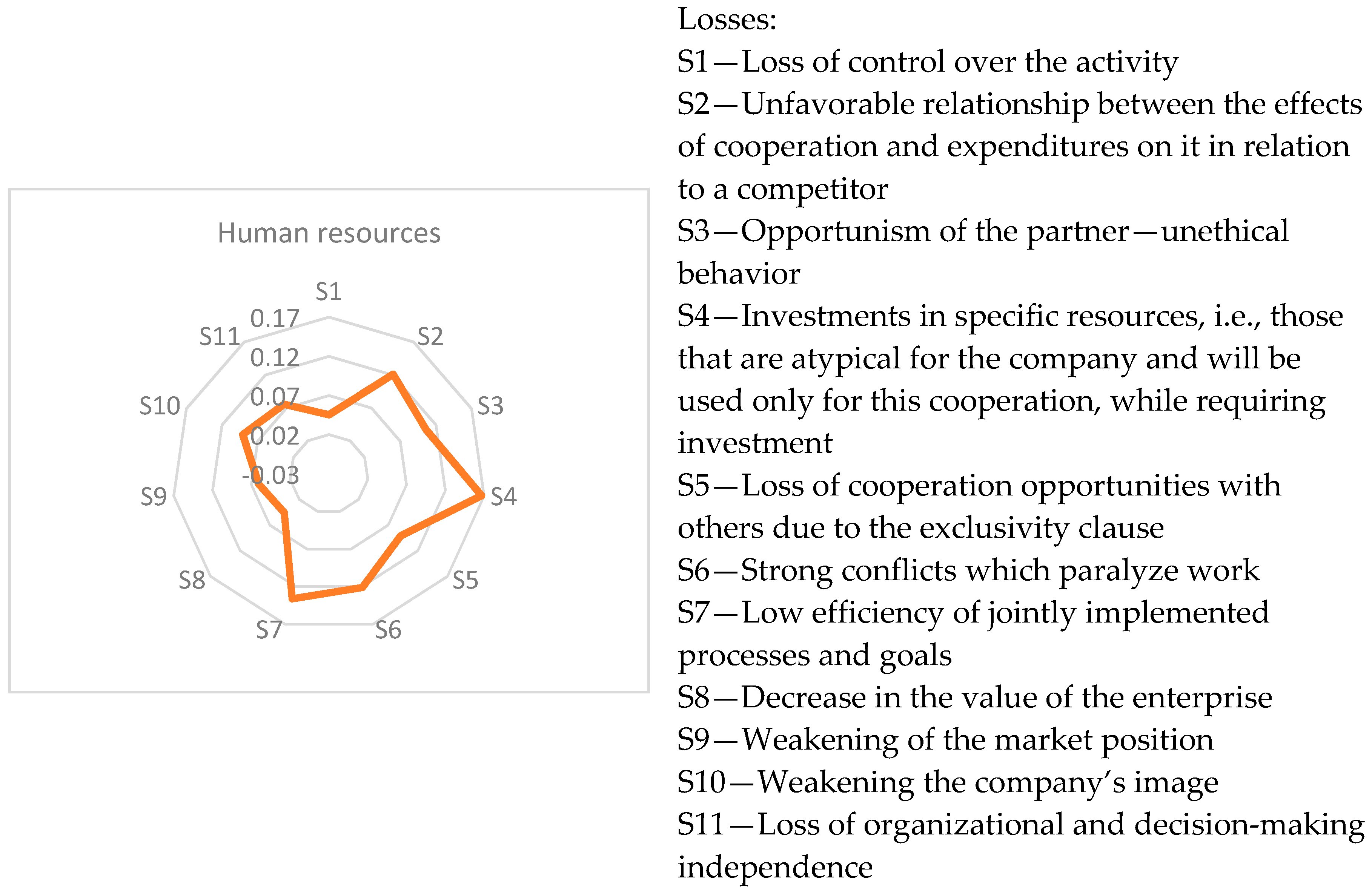
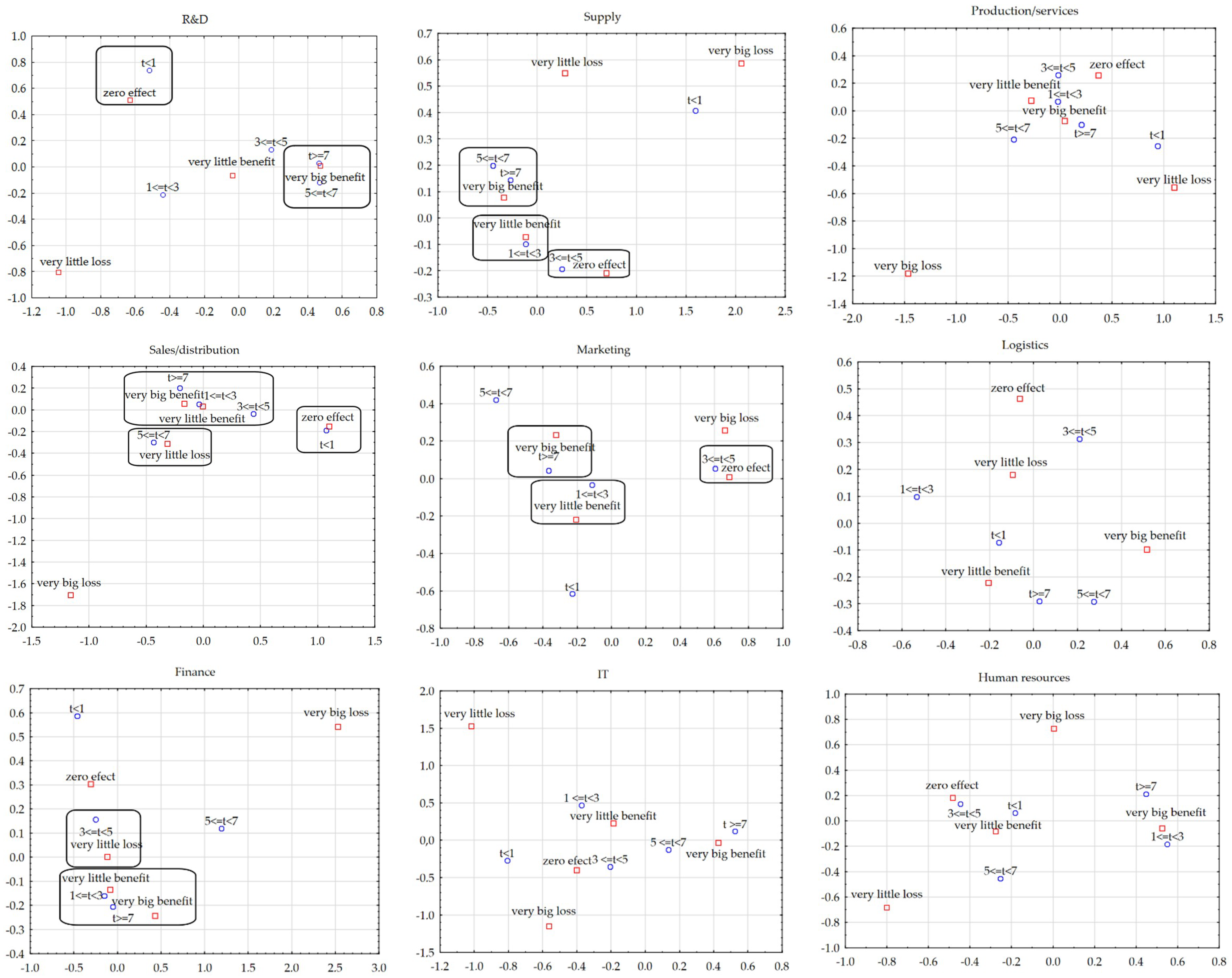
| Area of Coopetition | Chi-Square | p-Value | Cramer’s V Coefficient |
|---|---|---|---|
| R&D | 20.9040 | p = 0.0518 | 0.2897 |
| Supply | 38.6112 | p = 0.0075 | 0.2897 |
| Production/services | 19.8615 | p = 0.2265 | no significant dependence |
| Sales/distribution | 24.2292 | p = 0.0846 | 0.2166 |
| Marketing | 23.5530 | p = 0.0234 | 0.2788 |
| Logistics | 12.6121 | p = 0.3979 | no significant dependence |
| Finance | 24.1711 | p = 0.0858 | 0.2801 |
| IT | 20.5317 | p = 0.1972 | no significant dependence |
| Human resources | 17.9265 | p = 0.3282 | no significant dependence |
| Predecessor (Duration of Relationship) | ==> | Consequence (Benefit/Loss) | Support (%) | Confidence (%) | |
|---|---|---|---|---|---|
| R&D | |||||
| 1 | 5 ≤ t < 7 | ==> | Increase in innovativeness | 10.8434 | 69.2308 |
| 2 | t ≥ 7 | ==> | Cost reduction | 12.0482 | 58.8235 |
| 3 | t ≥ 7 | ==> | Acquiring unique knowledge | 12.0482 | 58.8235 |
| 4 | t ≥ 7 | ==> | Increase in innovativeness | 10.8434 | 52.9412 |
| Supply | |||||
| 1 | 1 ≤ t < 3 | ==> | Access to resources | 13.9130 | 53.3333 |
| 2 | 3 ≤ t < 5 | ==> | Reduction of transaction costs | 11.3044 | 37.1429 |
| 3 | t ≥ 7 | ==> | Cost reduction | 13.9130 | 59.2593 |
| Production/services | |||||
| 1 | 1 ≤ t < 3 | ==> | Access to resources | 13.5135 | 51.2821 |
| 2 | 3 ≤ t < 5 | ==> | Strengthening the position against other competitors | 11.4865 | 48.5714 |
| 3 | 3 ≤ t < 5 | ==> | Extending the scale of operations | 10.8108 | 45.7143 |
| 4 | t ≥ 7 | ==> | Cost reduction | 12.8378 | 50.0000 |
| Sales/distribution | |||||
| 1 | 3 ≤ t < 5 | ==> | Increase in company value | 11.6279 | 46.8750 |
| 2 | 3 ≤ t < 5 | ==> | Extending the scale of operations | 10.0775 | 40.6250 |
| 3 | t ≥ 7 | ==> | Cost reduction | 10.0775 | 34.2105 |
| Marketing | |||||
| 1 | 1 ≤ t < 3 | ==> | Access to resources | 10.8911 | 35.4839 |
| 2 | 3 ≤ t < 5 | ==> | Loss of independence | 10.8911 | 35.4839 |
| Logistics | |||||
| 1 | 1 ≤ t < 3 | ==> | Acquiring unique knowledge | 7.14286 | 37.5000 |
| 2 | 5 ≤ t < 7 | ==> | Reduction of transaction costs | 5.95238 | 45.4546 |
| 3 | 5 ≤ t < 7 | ==> | Extending the scale of operations | 5.95238 | 45.4546 |
| 4 | t ≥ 7 | ==> | Cost reduction | 9.5238 | 34.7826 |
| Finance | |||||
| 1 | 3 ≤ t < 5 | ==> | Cost reduction | 14.2857 | 52.3810 |
| IT | |||||
| 1 | 3 ≤ t < 5 | ==> | Access to resources | 11.7647 | 40.0000 |
| 2 | 3 ≤ t < 5 | ==> | Increase in innovativeness | 11.7647 | 40.0000 |
| 3 | 5 ≤ t < 7 | ==> | Cost reduction | 10.5882 | 52.9412 |
| 4 | t ≥ 7 | ==> | Acquiring unique knowledge | 10.5882 | 40.9091 |
| Human resources | |||||
| 1 | 1 ≤ t < 3 | ==> | Access to resources | 10.7692 | 58.3333 |
| 2 | 3 ≤ t < 5 | ==> | Increase in company value | 12.3077 | 33.3333 |
| 3 | 3 ≤ t < 5 | ==> | Reduction of the transaction costs | 12.3077 | 33.3333 |
| 4 | 3 ≤ t < 5 | ==> | Access to new markets | 12.3077 | 33.3333 |
© 2018 by the authors. Licensee MDPI, Basel, Switzerland. This article is an open access article distributed under the terms and conditions of the Creative Commons Attribution (CC BY) license (http://creativecommons.org/licenses/by/4.0/).
Share and Cite
Cygler, J.; Sroka, W.; Solesvik, M.; Dębkowska, K. Benefits and Drawbacks of Coopetition: The Roles of Scope and Durability in Coopetitive Relationships. Sustainability 2018, 10, 2688. https://doi.org/10.3390/su10082688
Cygler J, Sroka W, Solesvik M, Dębkowska K. Benefits and Drawbacks of Coopetition: The Roles of Scope and Durability in Coopetitive Relationships. Sustainability. 2018; 10(8):2688. https://doi.org/10.3390/su10082688
Chicago/Turabian StyleCygler, Joanna, Włodzimierz Sroka, Marina Solesvik, and Katarzyna Dębkowska. 2018. "Benefits and Drawbacks of Coopetition: The Roles of Scope and Durability in Coopetitive Relationships" Sustainability 10, no. 8: 2688. https://doi.org/10.3390/su10082688
APA StyleCygler, J., Sroka, W., Solesvik, M., & Dębkowska, K. (2018). Benefits and Drawbacks of Coopetition: The Roles of Scope and Durability in Coopetitive Relationships. Sustainability, 10(8), 2688. https://doi.org/10.3390/su10082688







